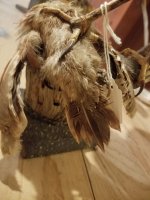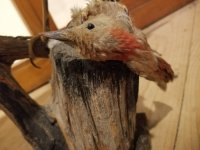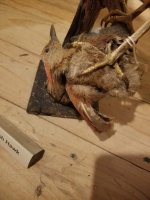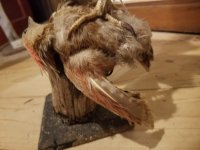Hi all, I hope this is the right place to post. I am a consulting conservator working with a natural history collection in an eastern U.S. nature center. Part of my job is to identify and catalogue each specimen, which has never formally been done, so many specimens do not have preexisting labels. Out of 700 birds, this one taxidermy mount has me completely stumped and I am hoping someone will know what it could be! The woodpecker in the picture is being captured and pinned by a northern harrier (circus hudsonius). The woodpecker doesn't seem to be native to the eastern U.S. like many of the other specimens in the collection. The mount is in fairly poor condition- the colors may have faded due to UV light exposure, or it may be a leucistic individual? It is small, around 20 cm in length. The mount is around 100 years old. Thanks for the help.
-
Welcome to BirdForum, the internet's largest birding community with thousands of members from all over the world. The forums are dedicated to wild birds, birding, binoculars and equipment and all that goes with it.
Please register for an account to take part in the discussions in the forum, post your pictures in the gallery and more.
You are using an out of date browser. It may not display this or other websites correctly.
You should upgrade or use an alternative browser.
You should upgrade or use an alternative browser.
Unusual Woodpecker ID in U.S. Taxidermy Collection (1 Viewer)
- Thread starter Afarquhar
- Start date
More options
Who Replied?
Sorry I can't I D these for you although I am thinking #2 & 3 represents a Red-bellied Woodpecker.
Hi there and a warm welcome to you from those of us on staff here at BirdForum
We're glad you found us and please join in wherever you like.
Hi there and a warm welcome to you from those of us on staff here at BirdForum
We're glad you found us and please join in wherever you like.
Last edited:
birdboybowley
Well-known member.....apparently so ;)

Surely a flicker?
Nothing I know of fits everything I am seeing here, but to me a juvenile Red-bellied Woodpecker fits better than a Northern Flicker. Flickers are always heavily spotted below, and we see no indication of that here. I can't account for the red tones on the wings, but the pattern there does not seem to match a flicker (or anything). It might help if the specimen were picked-up and some photos of its back taken.
Agree with this. My first impressions were (in order) flicker, then South American Celeus. But I couldn't make it fit either. But perhaps there's some imm flicker plumage I don't know ofNothing I know of fits everything I am seeing here, but to me a juvenile Red-bellied Woodpecker fits better than a Northern Flicker. Flickers are always heavily spotted below, and we see no indication of that here. I can't account for the red tones on the wings, but the pattern there does not seem to match a flicker (or anything). It might help if the specimen were picked-up and some photos of its back taken.
connorco
Well-known member

My first impression was something in Celeus rather than a flicker
Agree with this. My first impressions were (in order) flicker, then South American Celeus. But I couldn't make it fit either. But perhaps there's some imm flicker plumage I don't know of
AveryBartels
Well-known member
I applaud your thinking outside the box but in this case I think we can be confident it is indeed a woodpecker. The bill does look a tad odd but I think that is part due to the angle n each photo and perhaps shrinkage/loss of cartilage over time (?). To me it looks fine for a Woodpecker, and certainly not that of a Tanager. The tail feathers, with the thick shaft and pointed, tapered feather shape is also typical of a woodpecker.
I wonder if it could be a recently fledged Flicker, with a not fully grown bill and tail? Might also account for it's apparent stoutness?
I wonder if it could be a recently fledged Flicker, with a not fully grown bill and tail? Might also account for it's apparent stoutness?
I didn’t see the tail feathers so you’re probably correct there. I disagree about the bill. It looks just like my Scarlet Tanagers but not like my Red-bellied or Flickers.I applaud your thinking outside the box but in this case I think we can be confident it is indeed a woodpecker. The bill does look a tad odd but I think that is part due to the angle n each photo and perhaps shrinkage/loss of cartilage over time (?). To me it looks fine for a Woodpecker, and certainly not that of a Tanager. The tail feathers, with the thick shaft and pointed, tapered feather shape is also typical of a woodpecker.
I wonder if it could be a recently fledged Flicker, with a not fully grown bill and tail? Might also account for it's apparent stoutness?
Edit. Just had a look at one of my Flicker photos and the bill is more elongated, I wonder if a juvenile bill is shorter.
Last edited:
Similar threads
Users who are viewing this thread
Total: 2 (members: 0, guests: 2)








